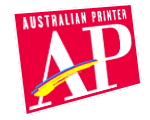Tags:
For Brisbane commercial printer, Crystal Media, moving from a film-based prepress environment to a new computer-to-plate system meant getting its skilled staff back into the jobs they were trained to do. Gavin Allen from Crystal Media says the recent installation of an Agfa :Acento platesetter running :Azura chemistry-free plates allowed the company to change its labour and skill mix to make work practices more efficient, and created some significant environmental advantages.“For us to put out the film, lay it up, shoot the plate and develop it all took a particular skill set and a lot of time,” says Allen.
Rather than use inexperienced operators who lack the knowledge or practice to find problems in the prepress process, Allen says the most experienced printer was used to ensure the best quality-control. His expertise helped minimise potential down time and ensured the job was performed as efficiently as possible.
“But it meant we had to take his skill out of the print room and put it into the prepress area – the opposite to what it should have been.”
With the Agfa CTP system installed, this experience has returned to the print room and the company has more flexibility to utilise staff.
“Before, the only guy we used to lay film was the guy who was skilled. Now, anyone can operate the platesetter, and in a printing company it is sometimes good to be able to take labour from one area to meet the demands in another,” says Allen.
“Just to show you how easy it is to run, our foreman had his seven-year-old son visiting him one day. When the platesetter needs a new plate it sounds a warning. His son heard it, got off his chair, pulled a new plate out and put it in and it was ready to go. His father had only showed him twice!”
The thermal platesetter, an external drum :Acento S (32-channel) with manual plate loading, features automatic plate size adjustment and inline punching. It outputs up to 20 plates an hour, with separate loading and unloading bays allowing one plate to be staged while another is being imaged. It handles standard thermal or :Azura plates from 324-370mm to 660x830mm.
Crystal Media has already taken steps to improve the environmental friendliness of its operation, moving to soy-based press inks and reducing alcohol use from 10 to three per cent. Adding the :Azura plate system means the whole print operation is virtually chemistry-free.
The :Azura system uses ThermoFuse technology to physically bond images to a thermal negative working plate. During exposure, a coating of ink-accepting latex particles absorbs heat in the image areas, fusing the particles together and bonding the images to the plate. Unlike standard processing which uses chemicals, the non-imaged areas are removed with gum in the compact C85 cleaning unit, and the plate is press-ready on exit.
No water is used in the plate processing. A 20 litre bottle of gum solution connects to the cleaning unit. The solution is drawn up through the unit and empties back into the bottle so is fully recycled. Allen notes the same bottle is still being used
after 1000 plates.
Crystal Media produce a broad range of high-end, 4-colour, offset printing, in runs up to 100,000. Allen says the :Azura plates have handled the work easily, including ‘bond’ paper (“the worst stock for plates”). With plate production increased to about 800 plates a month, previously labour-intensive jobs like small book runs of 2000 to 5000 are now possible.
System maintenance has also been minimised, says Allen. “There is absolutely no maintenance to do. We turn it off when we go and turn it on when we get in. After 2000 plates we’ve only had to do a five minute flush and clean of the system. In the past, no one wanted to clean the chemistry - it was a big, four-hour job. Now, it’s just taken that whole aspect out of it.”
A Xitron RIP, purchased 10 months earlier, drives the system. With this significant investment already made (both financially and in operator-familiarity), the new CTP system had to be compatible.
“A major factor in selecting the :Acento S was that the Xitron RIP could talk to it. We just changed the output device to ‘plate’. It’s a really simple system to run.”
Allen admits installing a new system was risky because they did not know what to expect. The old film equipment was kept aside while the new system was installed.
“But we were so confident that, by Wednesday, we were making plates. By Saturday we put everything from the old system in a big bin. I couldn’t see us ever going back and I haven’t even thought about it since.”







